The EPA Crackdown on Misleading Claims – A Storm is on the Horizon
Pause. Take a deep breath. Congratulations, you have just inhaled a ton of microorganisms! On average, we humans inhale around a million microorganisms per day[1]. The rates we consume vary upon numerous factors such as humidity, air circulation, day vs. night, amongst other factors. So, when we think about the wide frame of view of air purification, how are we supposed to know what to target?
Microorganisms are, for the most part, good for us. However, the bad ones that travel in the air must be at the forefront of our attention. UV-C disinfection for surfaces and objects is highly applicable and effective, but how can we utilize the strength of UV-C to help us control our indoor air quality?
UV-C for Air Purification
Reflecting back on how UV Light Kills Bacteria, how does UV-C air purification actually work when we know about the Bunsen-Roscoe Law and Newton’s Inverse Square Law? This next section will make your head spin a bit but don’t be alarmed. Let’s take a look various applications of UV-C in the realm of air purification starting with the least effective use; wall mounts & lamps.
If you observe your surroundings, you’ll see these UV-C mounts everywhere. In restaurants, office spaces, and some in hospitals…gasp! The reason for concern is due to the fact that these technologies are minimally effective in large areas and restricted to the limitations of the Laws above. For a quick refresher;
1.) Bunsen-Roscoe Law: the effect of UV-C light on a biological system is directly related to the total energy delivered, regardless of its administration.
2.) Newton’s Inverse Square Law: if you double the distance between subject and light source, it illuminates a surface area four times greater than before. A larger surface area will lead to a light intensity that is inversely proportional to the square of the distance.
A UV-C air purifying mount can only effectively disinfect the air immediately around it. The air in the further reaches of the room will not be touched by the lethal wavelength and necessary concentration of UV-C, meaning no disinfection is taking place. That being said, a great place to use a UV-C mount would be in travel spaces like buses or train cabins where the area of desired purification would be much smaller. And even then, these devices do not guarantee the air is purified.
A not-so-distant cousin of UV-C mounts are UV-C lamps. Another minimally effective application of UV-C in air purification. We run into the same limitations as the wall mount. In addition to their outputs and desired areas of disinfection, neither of these devices provide circulation so they are simply just for show. Circulation is a detrimental factor when identifying the best air purification devices. That being said, these two tools can provide sufficient targeted disinfection on surfaces and objects.
Photohydroionazation
The best use-cases of UV-C in air purification are the ones that can be installed into existing HVAC systems, are at the intersection of clean and dirty air, and can replace pesky HEPA filters.
For example, our Light Commercial PHI Unit can mount into the top of the air return ducts where dirty air filters up and becomes directly exposed to UV-C light. Additionally, the microbes are exposed to Advanced Oxidation Processes consisting of Hydro-peroxides, ozonide ions, superoxide ions, and hydroxide ions [all friendly oxidizers]. This means that they revert back to oxygen and hydrogen after the oxidation of the pollutant, giving us fresh air on the way out. A simple, yet elegant process.
Photon Multiplication – Declassified

Photon Multiplication is an older technology but you wouldn’t know that since it is just now being “declassified” and commercialized. The reason you’ve never heard of it through any mainstream channels, until now, is because it is a proprietary air sterilization technology which was funded by DARPA and integrated into The Pentagon as part of the Immune Building Program post-9/11.
This technology resides in a system called the AUVS BP 3131, the latest addition to Safety Net’s air purification portfolio. The 3131 embeds itself into air systems easily and creates a new, highly dangerous, intersection for airborne bacteria and pathogens to travel through.
What’s different about this technology, also one of the biggest proponents of its success, is that it accomplishes disinfection of rapidly moving air using a highly reflective chamber to contain and multiply the flux from high power UV lamps. The highly reflective surfaces inside of the chamber allow for UV-C irradiation to occur in seconds, achieving sterilization where other in-duct UV-C air units fall way short. This product has been tested to the highest degree imaginable and the kill times speak for themselves. Take a peek at the charts below and see that the proof is in the pudding. Keep in mind these results are achieved in 1 second. We’ll be doing a deep-dive piece on this incredible technology in the up & coming weeks.
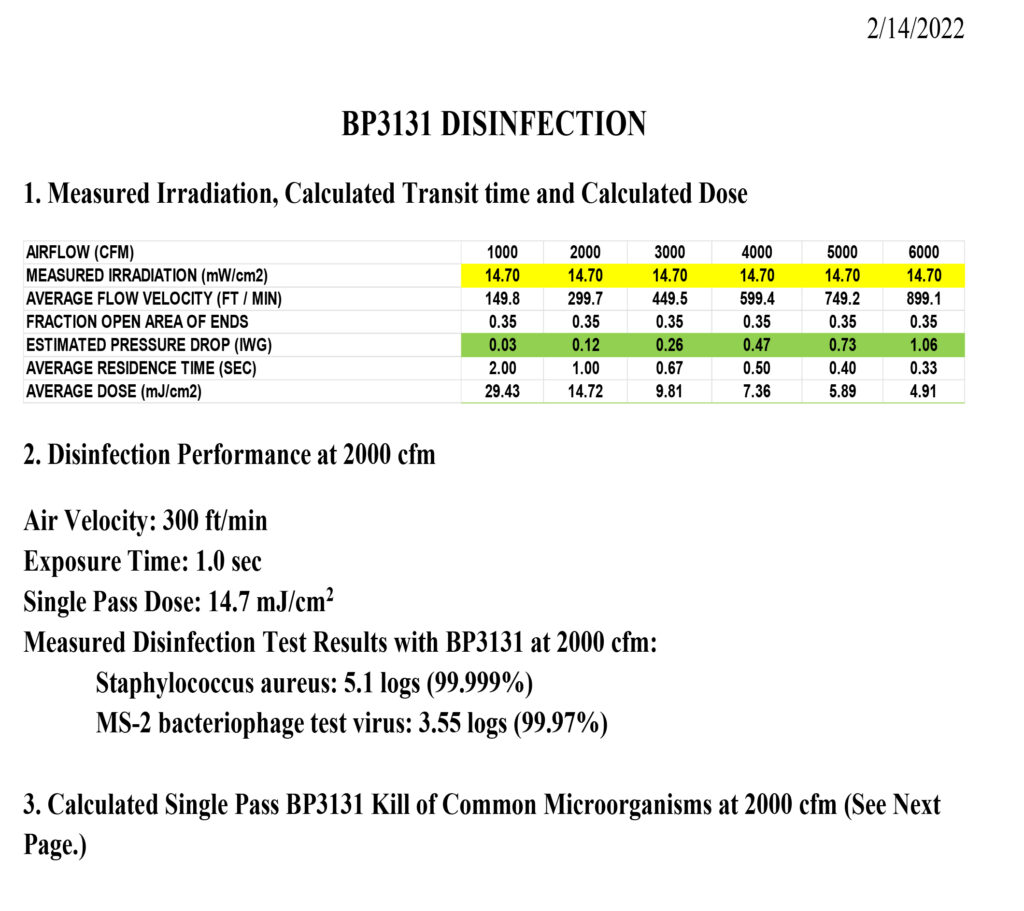
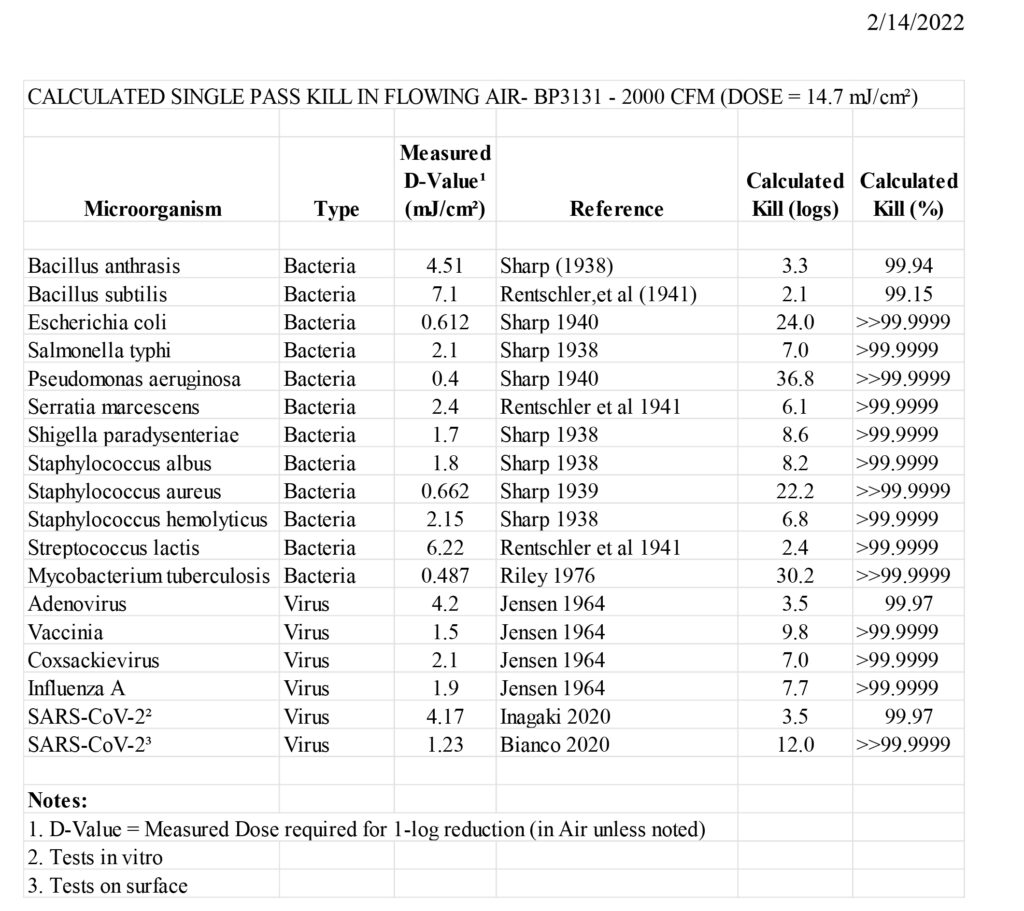
The Crackdown on UV Air Purification Claims
What constitutes a misleading claim? For nearly two years now, we have seen fraudulent air purification products hit all markets, and only now is the US Environmental Protection Agency cracking down on misleading claims. Better late than never, right? According to an article from UV Solutions,
“The EPA is generally focused on the following types of claims:
-Unqualified or generic claims about a purifier or filter’s ability to kill, capture, or otherwise eradicate “germs,” “viruses,” “bacteria,” “mold,” or “fungus” without specifying the species of microorganism on which the product has been tested or other supporting data.
-Claims that UV lights are “germicidal lights” and are “effective against most viruses, spores, and cysts,” unless the claims are qualified on labeling and supported by efficacy testing.
-Claims fail to distinguish whether efficacy testing was performed on a virus or a virus surrogate.
-Discrepancies between labels and labeling, especially between statements included in product containers and information on company websites.
-Claims that a given product or device is more effective than competing brands, without specifying the brands in question.
By focusing on such claims, the EPA is signaling that the industry must be prepared to support, with hard data, all product efficacy claims regarding regulated pesticide devices. Although the EPA is not describing its current mandate as a new policy, it present stance is not entirely aligned with its past regulatory posture, and certain apparent tensions stand to impose considerable burdens on the regulated industry.”

This crackdown is a good thing! The scientific method demands for hypotheses and products alike to be tested to the limit in-house, through third-party labs, and then tested again with the same results. Peer reviewed literature can play a drastic role in the credibility of science behind each product, providing consumers with the best.
Let’s look at some examples:
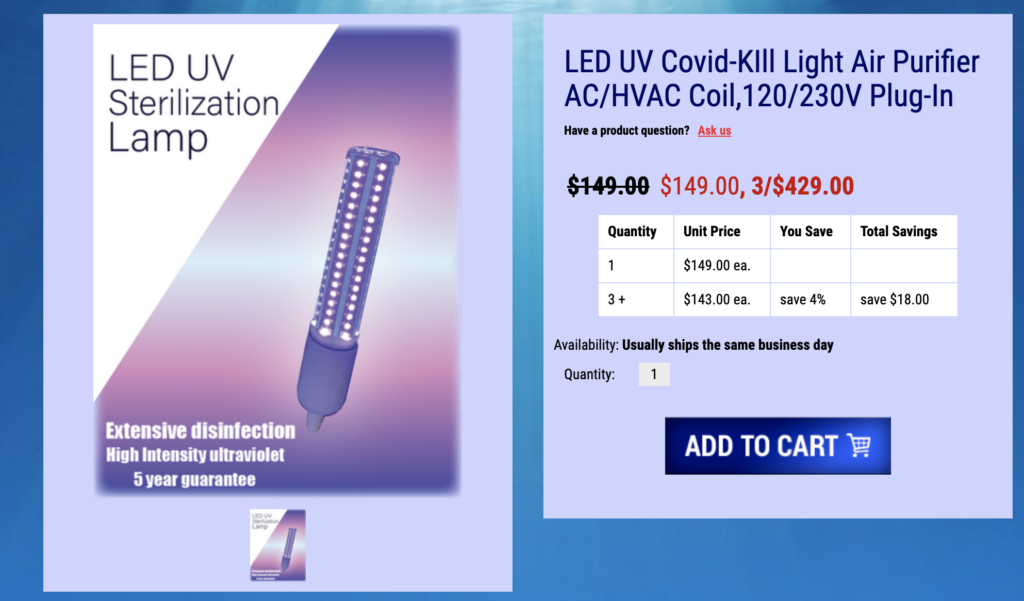
There is a lot to unpack from the picture above. First and foremost there is zero efficacy data on the page yet this device is claiming sterilization against COVID-19. That’s pretty specific yet there is no way to check these claims. We have no supplemental literature on the product, nor do we have any safety data sheets(SDS). Additionally, sterilization is the incorrect terminology for a device with this kind of power output. A picture speaks a thousand words, but this one only speaks three, “do not buy.”
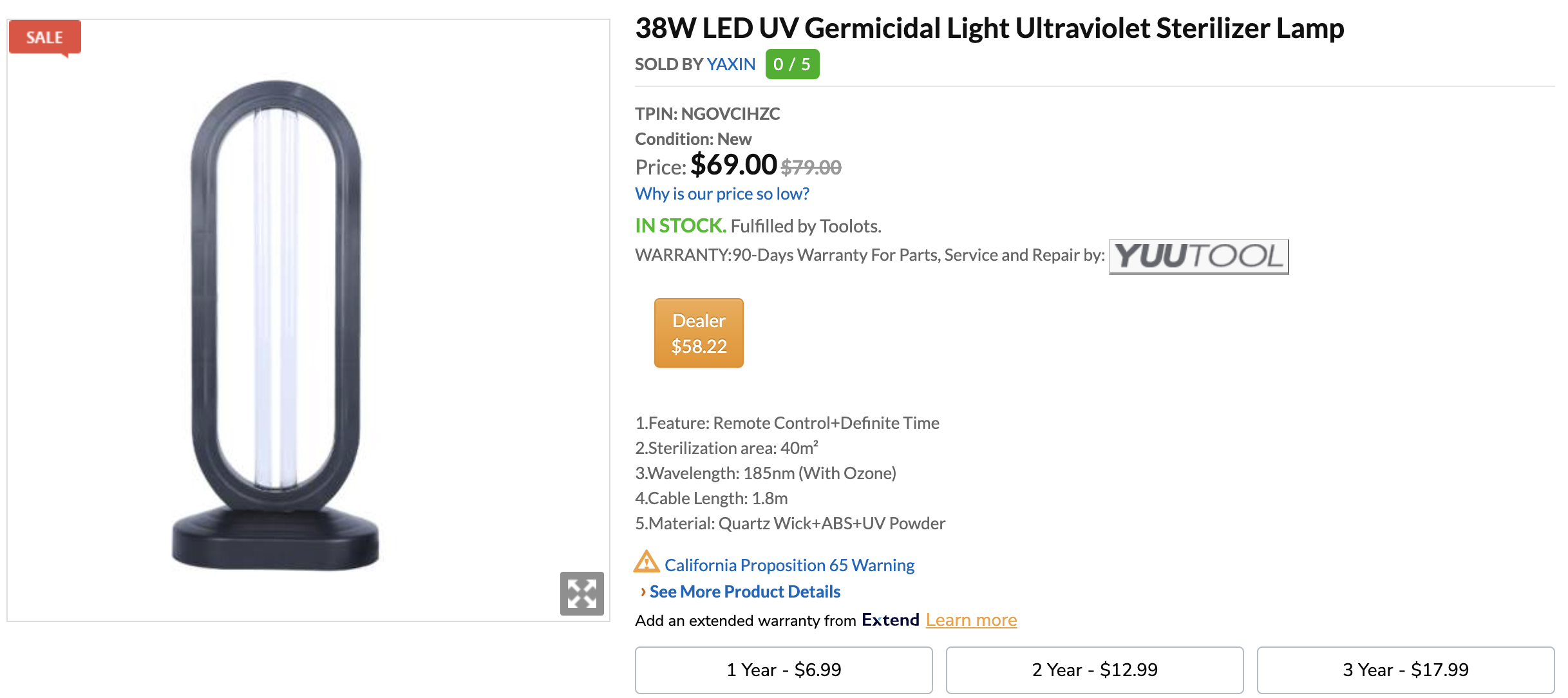
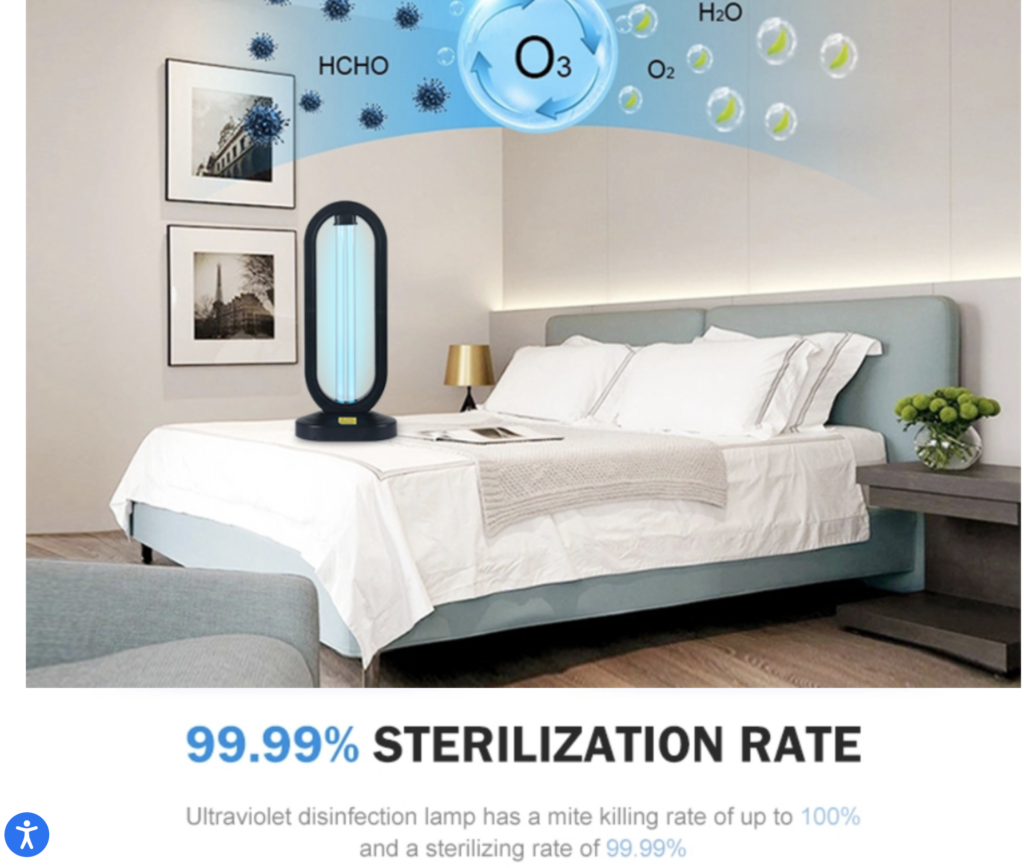
In the two pictures above let’s take note of the term “sterilization.” This term cannot be thrown around willy nilly. Sterilization is achieving a microbial kill of 99.9999% or greater. For a quick rundown on what logarithmic values are in the realm of disinfection review the following:

- A 1-log kill reduces the colony to 100,000 MRSA bacteria after a 90% reduction;
- A 2-log kill reduces the colony to 10,000 bacteria after a 99% reduction;
- A 3-log kill reduces the colony to 1,000 bacteria after a 99.9% reduction;
- A 4-log kill reduces the colony to 100 bacteria after a 99.99% reduction;
- A 5-log kill reduces the colony to 10 bacteria after a 99.999% reduction;
- A 6-log kill reduces the colony to 1 MRSA bacterium after a 99.9999% reduction.
As you can see, a 6-Log kill is the highest listed, anything beyond this point is considered “sterilized” or “sporicidal” and is borderline splitting hairs. Yet, to achieve this level of disinfection with UV-C for air purification, you need to be aligned with the two Laws above [no shortcuts permitted] and the disinfection methodology needs to be scrupulously tested against a wide-range of viruses and bacteria. Data needs to then be presented in a clear-cut manner, avoiding clickbait titles like “COVID-Kill.”
Consult Before Commitment
After two articles dedicated to the realm of ultraviolet disinfection, the takeaway needs to be that the devil is in the details. We’ve explored the science of UV disinfection and taken a trip down UV air purification lane, we’ve got a firm grasp on where the EPA is focusing their enforcement, and we now know what to look for when browsing these products. So let’s step out of the darkness of confusion and into the ultraviolet light with a newfound understanding of how this gift from our sun can be utilized to protect us.
Like financial advising, it is best to consult with people who have been in the industry and understand the nitty-gritty details. Safety Net consults for FREE! Yes, you read that right. Before bidding on products or purchasing, don’t hesitate to reach out to us and ask questions. We can provide relevant data or lack thereof and include counter-recommendations with scientific support to back these recommendations. It’s time for the experts to have their day in the sun, and for those capitalizing on the “gold rush” of infection control, there’s a storm on the horizon.
About the Author
Robert Hasselfeld is SEO manager for Safety Net.
[1] Gusareva, E. S., Acerbi, E., Lau, K. J. X., Luhung, I., Premkrishnan, B. N. V., Kolundžija, S., Purbojati, R. W., Wong, A., Houghton, J. N. I., Miller, D., Gaultier, N. E., Heinle, C. E., Clare, M. E., Vettath, V. K., Kee, C., Lim, S. B. Y., Chénard, C., Phung, W. J., Kushwaha, K. K., … Schuster, S. C. (2019). Microbial communities in the tropical air ecosystem follow a precise diel cycle. Proceedings of the National Academy of Sciences, 46, 23299–23308. https://doi.org/10.1073/pnas.1908493116

